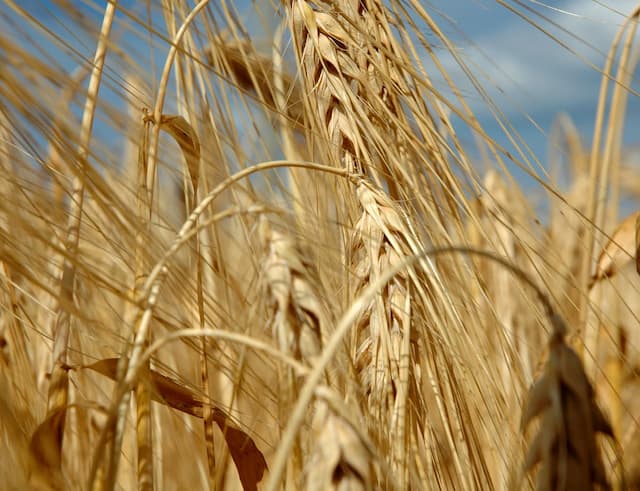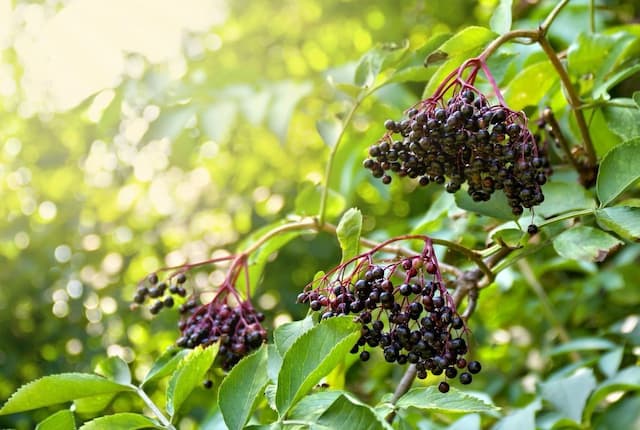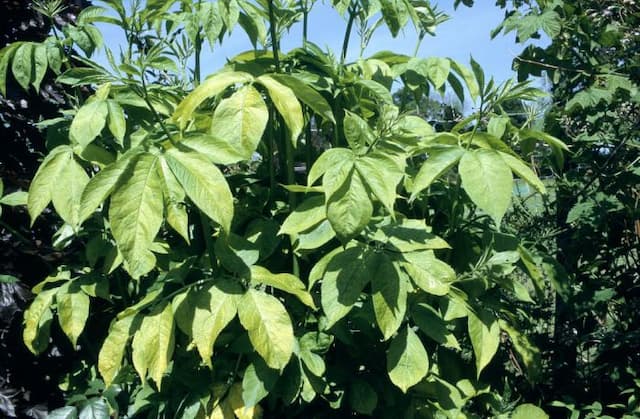Burkwood Viburnum Viburnum × burkwoodii 'Park Farm Hybrid'

ABOUT
The Viburnum 'Park Farm Hybrid' is a beautiful ornamental shrub that is widely appreciated for its aesthetic appeal in gardens. This plant produces a profusion of fragrant flowers that are typically white or lightly tinged with pink. These blossoms cluster together to form rounded, snowball-like inflorescences that cover the bush in a spectacular floral display during its blooming season, which adds to its ornamental value. The foliage of 'Park Farm Hybrid' adds to its visual interest, with leaves that are dark green and glossy, creating a lush backdrop for the bright flowers. The leaves are broad and somewhat oval in shape, with softly serrated edges that can provide texture to the plant's overall appearance. During the fall, the foliage may take on additional hues, adding a touch of seasonal color change to the landscape, although the exact color transformation can vary. The structure of Viburnum 'Park Farm Hybrid' is sturdy, with branches that form an attractive, dense and rounded shape. This self-contained growth habit makes it suitable for use as a specimen plant, or as part of a hedge or mixed border. In terms of cultural preferences, the plant is generally hardy and can adapt to a variety of soil types, though it flourishes best in conditions that provide well-drained soil and ample moisture. It enjoys full sun to partial shade, which allows its flowers to bloom most profusely. The 'Park Farm Hybrid' is a relatively low-maintenance plant, making it a popular choice for both novice and experienced gardeners alike. Overall, Viburnum 'Park Farm Hybrid' strikes a lovely balance of showy, aromatic flowers and attractive, resilient foliage that makes it a favorite in many ornamental gardens. Its year-round appeal, with the added benefit of seasonal color changes and ease of care, only add to its desirability for gardeners looking to enhance the beauty of their outdoor spaces.
About this plant
 Names
NamesSynonyms
Burkwood Viburnum, Park Farm Hybrid.
Common names
Viburnum × burkwoodii 'Park Farm Hybrid'.
 Toxicity
ToxicityTo humans
The Burkwood Viburnum is not considered highly toxic to humans. However, ingestion of parts of the plant, particularly the berries, can potentially cause mild stomach upset if consumed in large quantities. Symptoms may include nausea, vomiting, and diarrhea. It is important to practice caution and avoid eating any part of ornamental plants unless they are known to be edible.
To pets
The Burkwood Viburnum may cause mild to moderate gastrointestinal upset in pets if ingested, including symptoms such as vomiting, diarrhea, and drooling. While the plant is not considered highly toxic, it's always best to prevent pets from consuming plant material to avoid any potential issues. If you suspect your pet has ingested parts of this plant, it is advisable to consult a veterinarian.
 Characteristics
CharacteristicsLife cycle
Perennials
Foliage type
Semi-deciduous
Color of leaves
Green
Flower color
Pink
Height
6-8 feet (1.8-2.4 meters)
Spread
6-8 feet (1.8-2.4 meters)
Plant type
Shrub
Hardiness zones
5
Native area
Cultivar
Benefits
 General Benefits
General Benefits- Aesthetic Appeal: Adds visual interest to gardens with its attractive foliage and flowers.
- Fragrance: Emits a pleasant scent from its flowers, enhancing the sensory experience in the garden.
- Wildlife Attraction: Attracts birds and pollinators like bees and butterflies to the garden.
- Seasonal Interest: Offers multi-season interest with flowers in spring and often colorful berries and foliage in autumn.
- Privacy Screen: Can be used to create a natural privacy screen or hedge due to its dense growth habit.
- Low Maintenance: Generally requires minimal care once established, making it suitable for a variety of gardeners.
- Hardiness: Tolerates a range of temperatures and can thrive in many climate zones.
- Versatility: Suitable for a variety of landscape uses including borders, specimen planting, and foundation planting.
 Medical Properties
Medical PropertiesThis plant is not used for medical purposes.
 Air-purifying Qualities
Air-purifying QualitiesThis plant is not specifically known for air purifying qualities.
 Other Uses
Other Uses- Viburnum x burkwoodii 'Park Farm Hybrid,' commonly known as Burkwood Viburnum, can be used in floral arrangements; its fragrant flowers can add a sweet aroma and aesthetic appeal to bouquets and centerpieces.
- The dense foliage of Burkwood Viburnum offers a natural shelter for birds and small wildlife, providing a safe space for nesting and refuge from predators.
- This plant’s sturdy branches can be used for crafting small garden structures like trellises or plant supports, lending a rustic charm to the garden aesthetic.
- Burkwood Viburnum's wood is sometimes utilized in the creation of small wooden items such as tool handles, owing to its hard and durable properties.
- The vibrant autumn color change of the leaves provides excellent opportunities for photography, where the plant can serve as a captivating subject or backdrop.
- Cultivated varieties of Burkwood Viburnum can be used in topiary art, where its growth pattern can be shaped and maintained to form decorative living sculptures.
- The visually pleasing form of Burkwood Viburnum can be incorporated into landscape design as a focal point or feature plant, enhancing the aesthetic of parks and gardens.
- In educational settings, this plant can be utilized as a teaching tool to demonstrate crossbreeding and hybridization in plants, as 'Park Farm Hybrid' is a product of such practices.
- During festive seasons, branches of Burkwood Viburnum bearing berries can be collected and used to add a natural touch to holiday decorations and wreaths.
- Pet owners sometimes use the dense thicket-like growth of the Burkwood Viburnum as a secure boundary for pets to roam freely within the confines of the yard.
Interesting Facts
 Feng Shui
Feng ShuiBurkwood Viburnum is not used in Feng Shui practice.
 Zodiac Sign Compitability
Zodiac Sign CompitabilityBurkwood Viburnum is not used in astrology practice.
 Plant Symbolism
Plant Symbolism- Renewal: The Viburnum × burkwoodii 'Park Farm Hybrid', commonly known as Burkwood Viburnum, often blooms in the spring, symbolizing new beginnings and the renewal of life.
- Protection: In some cultures, viburnums are considered a symbol of protection because their dense foliage can provide shelter for birds and other wildlife.
- Abundance: The prolific flowers of the Burkwood Viburnum, which appear in clusters, can signify abundance and generosity.
 Water
WaterFor the Burkwood Viburnum, thorough watering is important when the soil becomes dry to the touch, which could be every 7 to 10 days during active growth in the spring and summer, depending on climate conditions. Ensure the plant receives about 1 to 1.5 gallons of water at each watering session to thoroughly moisten the root zone. In the fall and winter, reduce the frequency as the plant requires less water during dormancy. Be cautious not to overwater, as this can lead to root rot. It’s best to water deeply and less frequently to encourage strong root development.
 Light
LightThe Burkwood Viburnum thrives best in full sun to partial shade conditions. A spot that provides morning sun with dappled afternoon shade is ideal, especially in areas with hot summers. Avoid deep shade as it can lead to sparse flowering and an open, less attractive growth habit.
 Temperature
TemperatureThe Burkwood Viburnum is hardy and can withstand temperatures as low as -10°F and high temperatures typical of many temperate regions. The ideal growing temperature range for the Burkwood Viburnum is between 40°F and 75°F. Protection from extreme heat or cold is beneficial to avoid stress on the plant.
 Pruning
PruningPruning the Burkwood Viburnum is done to maintain its shape, remove any dead or diseased wood, and promote denser growth. Prune immediately after flowering, typically in late spring or early summer, to avoid removing next year's flower buds. Deadheading spent flowers can also encourage a tidier appearance, but it's not strictly necessary for the health of the plant.
 Cleaning
CleaningAs needed
 Soil
SoilThe Burkwood Viburnum thrives in moderately fertile, well-drained soil with a slightly acidic to neutral pH, generally in the range of pH 5.5 to 7.0. A mix of loamy soil, peat, and sand in equal parts creates an ideal growing medium for this plant. Providing mulch can help maintain soil moisture and improve soil structure over time.
 Repotting
RepottingBurkwood Viburnum, being a relatively large shrub, is typically not repotted as it is grown outdoors. Instead, it may require occasional transplanting if it outgrows its space or if conditions necessitate a move. In gardens, ensuring that the soil remains fertile and well-drained is more critical than repotting.
 Humidity & Misting
Humidity & MistingBurkwood Viburnum prefers outdoor conditions where it is exposed to natural humidity levels that do not require specific control. It is adaptable to a range of humidity levels and does not have special humidity requirements when planted in a typical garden setting.
 Suitable locations
Suitable locationsIndoor
Place in bright, indirect light and ensure adequate room for growth.
Outdoor
Choose a spot with full sun to partial shade and well-drained soil.
Hardiness zone
5-8 USDA
 Life cycle
Life cycleViburnum × burkwoodii 'Park Farm Hybrid', commonly known as the Burkwood Viburnum, begins its life as a seed or through root cuttings, where it undergoes germination once it's exposed to the right conditions of moisture and temperature. Upon germination, the seedling emerges and establishes roots, followed by the development of foliage as it becomes a young plant; during this vegetative stage, it focuses on growth and leaf production. The Burkwood Viburnum reaches maturity within a few years, at which point it produces clusters of fragrant flowers in the spring, typically followed by berry-like fruit that can attract birds and other wildlife. After the flowering and fruiting stage, the plant enters a period of dormancy during the colder months, conserving energy and resources. The cycle repeats seasonally with new growth in the spring, flowering, and possibly the production of seeds through pollination, allowing for the potential spread and regeneration of new plants. This plant can live for many years, going through these growth stages repeatedly unless affected by environmental stresses, disease, or aging.
 Propogation
PropogationPropogation time
Spring-Early Summer
The most popular method of propagating Viburnum × burkwoodii 'Park Farm Hybrid', commonly known as the Burkwood Viburnum, is through semi-hardwood cuttings. This method typically takes place during the late summer. To propagate, one selects a current season's growth that has begun to mature and harden slightly, often indicated by a change in the color of the stem from green to a woody brown shade. The cutting should be about 4 to 6 inches (approximately 10 to 15 centimeters) in length and include several leaf nodes. Leaves on the lower half of the cutting are removed and the cut end is often dipped in a rooting hormone to encourage root development. The prepared cutting is then inserted into a well-draining rooting medium such as a mix of peat and perlite. The cuttings are kept moist and in a warm environment with indirect light until roots have developed, after which they can be potted up individually and acclimatized to outdoor conditions.



![Elder [Black Tower]](/_next/image?url=https%3A%2F%2Fplants-admin.emdemapps.com%2Fimages%2Fplants%2F%2Fimages%2F604b5cad99578.png&w=640&q=75)





